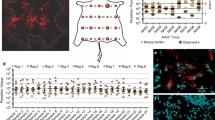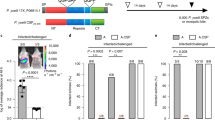Abstract
Infection by malaria parasites begins with the inoculation of sporozoites into the skin of the host. The early events following sporozoite deposition in the dermis are critical for both the establishment of malaria infection and for the induction of protective immune responses. The initial sporozoite inoculum is generally low, and only a small percentage of these sporozoites successfully reach the liver and grow to the next life cycle stage, making this a significant bottleneck for the parasite. Recent studies highlight the importance of sporozoite motility and host cell traversal in dermal exit. Importantly, protective immune responses against sporozoites and liver stages of Plasmodium are induced by dendritic cells in the lymph node draining the skin inoculation site. The cellular, molecular, and immunological events that occur in the skin and associated lymph nodes are the topic of this review.
Similar content being viewed by others
References
Yamauchi LM, Coppi A, Snounou G, Sinnis P (2007) Plasmodium sporozoites trickle out of the injection site. Cell Microbiol 9:1215–1222
Chakravarty S, Cockburn IA, Kuk S, Overstreet MG, Sacci JB, Zavala F (2007) CD8(+) T lymphocytes protective against malaria liver stages are primed in skin-draining lymph nodes. Nat Med 13:1035–1041
Matsuoka H, Yoshida S, Hirai M, Ishii A (2002) A rodent malaria, Plasmodium berghei, is experimentally transmitted to mice by merely probing of infective mosquito, Anopheles stephensi. Parasitol Int 51:17–23
Sidjanski S, Vanderberg JP (1997) Delayed migration of Plasmodium sporozoites from the mosquito bite site to the blood. AmJTrop Med Hyg 57:426–429
Medica DL, Sinnis P (2005) Quantitative dynamics of Plasmodium yoelii sporozoite transmission by infected anopheline mosquitoes feeding on vertebrate hosts. Infect Immun 73:4363–4369
Rosenberg R, Wirtz RA, Schneider I, Burge R (1990) An estimation of the number of malaria sporozoites ejected by a feeding mosquito. Trans Roy Soc Trop Med Hyg 84:209–212
Beier JC, Onyango FK, Koros JK, Ramadhan M, Ogwang R, Wirtz R, Koech DK, Roberts CR (1991) Quantitation of malaria sporozoites transmitted in vitro during salivation by wild Afrotropical Anopheles. Med Vet Entomol 5:71–79
Amino R, Thiberge S, Martin B, Celli S, Shorte S, Frischknecht F, Menard R (2006) Quantitative imaging of Plasmodium transmission from mosquito to mammal. Nat Med 12:220–224
Vanderberg J, Frevert U (2004) Intravital microscopy demonstrating antibody-mediated immobilisation of Plasmodium berghei sporozoites injected into skin by mosquitoes. Int J Parasitol 34:991–996
Lloyd OC, Sommerville T (1949) The fate of sporozoites of Plasmodium cynomolgi injected into the skin of rhesus monkeys. Proc Path Soc 61:144–146
Gueirard P, Tavares J, Thiberge S, Bernex F, Ishino T, Milon G, Franke-Fayard B, Janse CJ, Ménard R, Amino R (2010) Development of the malaria parasite in the skin of the mammalian host. Proc Natl Acad Sci USA 107:18640–18645
Voza T, Miller JL, Kappe SH, Sinnis P (2012) Extrahepatic exoerythrocytic forms of rodent malaria parasites at the site of inoculation: clearance after immunization, susceptibility to primaquine and contribution to blood stage infection. Infect Immun 80:2158–2164
Kappe SH, Buscaglia CA, Bergman LW, Coppens I, Nussenzweig V (2004) Apicomplexan gliding motility and host cell invasion: overhauling the motor model. Trends Parasitol 20:13–16
Sultan AA, Thathy V, Frevert U, Robson KJH, Crisanti A, Nussenzweig V, Nussenzweig RS, Menard R (1997) TRAP is necessary for gliding motility and infectivity of Plasmodium sporozoites. Cell 90:511–522
Ejigiri I, Ragheb DRT, Pino P, Coppi A, Bennett BL, Soldati-Favre D, Sinnis P (2012) Shedding of TRAP by a rhomboid protease from the malaria sporozoite surface is essential for gliding motility and sporozoite infectivity. PLoS Path 8:e1002725
Amino R, Giovannini D, Thiberge S, Gueirard P, Boisson B, Dubremetz JF, Prévost MC, Ishino T, Yuda M, Ménard R (2008) Host cell traversal is important for progression of the malaria parasite through the dermis to the liver. Cell Host Microbe 3:88–96
Coppi A, Tewari R, Bishop J, Lawrence R, Esko J, Billker O, Sinnis P (2007) Heparan sulfate proteoglycans provide a signal to sporozoites to stop migrating and to productively invade cells. Cell Host Microbe 2:316–327
Ishino T, Yano K, Chinzei Y, Yuda M (2004) Cell-passage activity is required for the malarial parasite to cross the liver sinusoidal cell layer. PLoS Biol 2:77–84
Ishino T, Chinzei Y, Yuda M (2005) A Plasmodium sporozoite protein with a membrane attack complex domain is required for breaching the liver sinusoidal cell layer prior to hepatocyte infection. Cell Microbiol 7:199–208
Kariu T, Ishino T, Yano K, Chinzei Y, Yuda M (2006) CelTOS, a novel malarial protein that mediates transmission to mosquito and vertebrate hosts. Mol Microbiol 59:1369–1379
Coppi A, Natarajan R, Pradel G, Bennett BL, James ER, Roggero MA, Corradin G, Persson C, Tewari R, Sinnis P (2011) The malaria circumsporozoite protein has two functional domains, each with distinct roles as sporozoites journey from mosquito to mammalian host. J Exp Med 208:341–356
Schofield L, Villaquiran J, Ferreira A, Schellekens H, Nussenzweig R, Nussenzweig V (1987) Gamma interferon, CD8+ T cells and antibodies required for immunity to malaria sporozoites. Nature 330:664–666
Weiss WR, Sedegah M, Beaudoin RL, Miller LH, Good MF (1988) CD8+ T cells (cytotoxic/suppressors) are required for protection in mice immunized with malaria sporozoites. Proc Natl Acad Sci USA 85:573–576
Romero P, Maryanski JL, Corradin G, Nussenzweig RS, Nussenzweig V, Zavala F (1989) Cloned cytotoxic T cells recognize an epitope in the circumsporozoite protein and protect against malaria. Nature 341:323–326
Spitalny GL, Nussenzweig RS (1972) Effect of various routes of immunization and methods of parasite attenuation on the development of protection against sporozoite-induced rodent malaria. Proc Helm Soc 39:506–514
Hafalla JC, Rai U, Morrot A, Bernal-Rubio D, Zavala F, Rodriguez A (2006) Priming of CD8+ T cell responses following immunization with heat-killed Plasmodium sporozoites. Eur J Immunol 36:1179–1186
Plebanski M, Hannan CM, Behboudi S, Flanagan KL, Apostolopoulos V, Sinden RE, Hill AVS (2005) Direct processing and presentation of antigen from malaria sporozoites by professional antigen-presenting cells in the induction of CD8+ T-cell responses. Immunol Cell Biol 83:307–312
Jobe O, Donofrio G, Sun G, Liepinsh D, Schwenk R, Krzych U (2009) Immunization with radiation-attenuated Plasmodium berghei sporozoites induces liver CD8+ DC that activate CD8 + T Cells against liver-stage malaria. PLoS One 4:e5075
Jung S, Unutmaz D, Wong P, Sano G-I, De los Santos K, Sparwasser T, Wu S, Vuthoori S, Ko K, Zavala F et al (2002) In vivo depletion of CD11c + dendritic cells abrogates priming of CD8+ T cells by exogenous cell-associated antigens. Immunity 17:211–220
Radhakrishnan S, Celis E, Pease LR (2005) B7-DC cross-linking restores antigen uptake and augments antigen-presenting cell function by matured dendritic cells. Proc Natl Acad Sci USA 102:11438–11443
Wilson NS, Behrens GMN, Lundie RJ, Smith CM, Waithman J, Young L, Forehan SP, Mount A, Steptoe RJ, Shortman KD et al (2006) Systemic activation of dendritic cells by Toll-like receptor ligands or malaria infection impairs cross-presentation and antiviral immunity. Nat Immunol 7:165–172
Cockburn IA, Tse S-W, Radtke AJ, Srinivasan P, Chen Y-C, Sinnis P, Zavala F (2011) Dendritic cells and hepatocytes use distinct pathways to process protective antigen from Plasmodium in vivo. PLoS Pathog 7:e1001318
Tabeta K, Hoebe K, Janssen EM, Du X, Georgel P, Crozat K, Mudd S, Mann N, Sovath S, Goode J et al (2006) The Unc93b1 mutation 3d disrupts exogenous antigen presentation and signaling via Toll-like receptors 3, 7 and 9. Nat Immunol 7:156–164
Lin ML, Zhan Y, Proietto AI, Prato S, Wu L, Heath WR, Villadangos JA, Lew AM (2008) Selective suicide of cross-presenting CD8+ dendritic cells by cytochrome c injection shows functional heterogeneity within this subset. Proc Natl Acad Sci USA 105:3029–3034
Farrand KJ, Dickgreber N, Stoitzner P, Ronchese F, Petersen TR, Hermans IF (2009) Langerin+CD8+ dendritic cells are critical for cross-priming and IL-12 production in response to systemic antigens. J Immunol 183:7732–7742
Qiu C-H, Miyake Y, Kaise H, Kitamura H, Ohara O, Tanaka M (2009) Novel subset of CD8+ dendritic cells localized in the marginal zone is responsible for tolerance to cell-associated antigens. J Immunol 182:4127–4136
Bedoui S, Whitney PG, Waithman J, Eidsmo L, Wakim L, Caminschi I, Allan RS, Wojtasiak M, Shortman K, Carbone FR et al (2009) Cross-presentation of viral and self antigens by skin-derived CD103+ dendritic cells. Nat Immunol 10:488–495
Bursch LS, Wang L, Igyarto B, Kissenpfennig A, Malissen B, Kaplan DH, Hogquist KA (2007) Identification of a novel population of Langerin + dendritic cells. J Exp Med 204:3147–3156
Poulin LF, Henri S, de Bovis B, Devilard E, Kissenpfennig A, Malissen B (2007) The dermis contains langerin + dendritic cells that develop and function independently of epidermal Langerhans cells. J Exp Med 204:3119–3131
Ginhoux F, Collin MP, Bogunovic M, Abel M, Leboeuf M, Helft J, Ochando J, Kissenpfennig A, Malissen B, Grisotto M et al (2007) Blood-derived dermal langerin+ dendritic cells survey the skin in the steady state. J Exp Med 204:3133–3146
Allan RS, Waithman J, Bedoui S, Jones CM, Villadangos JA, Zhan Y, Lew AM, Shortman K, Heath WR, Carbone FR (2006) Migratory dendritic cells transfer antigen to a lymph node-resident dendritic cell population for efficient CTL priming. Immunity 25:153–162
Cockburn IA, Chen Y-C, Overstreet MG, Lees JR, van Rooijen N, Farber DL, Zavala F (2010) Prolonged antigen presentation is required for optimal CD8+ T cell responses against malaria liver stage parasites. PLoS Pathog 6:e1000877
Vanderberg J, Nussenzweig RS, Most H, Orton CG (1968) Protective immunity produced by the injection of x-irradiated sporozoites of Plasmodium berghei. J Parasitol 54:1175–1180
Silvie O, Semblat JP, Franetich JF, Hannoun L, Eling W, Mazier D (2002) Effects of irradiation on Plasmodium falciparum sporozoite hepatic development: implications for the design of pre-erythrocytic malaria vaccines. Parasite Immunol 24:221–223
Klenerman P, Hill A (2005) T cells and viral persistence: lessons from diverse infections. Nat Immunol 6:873–879
Shin H, Wherry EJ (2007) CD8 T cell dysfunction during chronic viral infection. Curr Opin Immunol 19:408–415
Epstein JE, Rao S, Williams F, Freilich D, Luke T, Sedegah M, de la Vega P, Sacci J, Richie TL, Hoffman SL (2007) Safety and clinical outcome of experimental challenge of human volunteers with Plasmodium falciparum infected mosquitoes: an update. J Infect Dis 196:145–154
Voza T, Kebaier C, Vanderberg JP (2010) Intradermal immunization of mice with radiation-attenuated sporozoites of Plasmodium yoelii induces effective protective immunity. Malar J 9:362
Inoue M, Culleton RL (2011) The intradermal route for inoculation of sporozoites of rodent malaria parasites for immunological studies. Parasite Immunol 33:137–142
Leitner WW, Bergmann-Leitner ES, Angov E (2010) Comparison of Plasmodium berghei challenge models for the evaluation of pre-erythrocytic malaria vaccines and their effect on perceived vaccine efficacy. Malar J 9:145
Conteh S, Chattopadhyay R, Anderson C, Hoffman SL (2010) Plasmodium yoelii-infected A. stephensi inefficiently transmit malaria compared to intravenous route. PLoS One 5:e8947
Acknowledgments
PS is supported by NIH R01 AI056840 and FZ by NIH R01 AI44375. The authors are grateful for the support of the Bloomberg Family Foundation. The authors declare no financial conflicts of interest.
Author information
Authors and Affiliations
Corresponding authors
Additional information
This article is a contribution to the special issue on Immunoparasitology - Guest Editor: Miguel Stadecker
Rights and permissions
About this article
Cite this article
Sinnis, P., Zavala, F. The skin: where malaria infection and the host immune response begin. Semin Immunopathol 34, 787–792 (2012). https://doi.org/10.1007/s00281-012-0345-5
Received:
Accepted:
Published:
Issue Date:
DOI: https://doi.org/10.1007/s00281-012-0345-5




